 This dress is very special to me. Not for being obviously fancy, but because I made it when I was 18 years old, which seems like in another life now! I clearly remember being totally obsessed with everything eighteenth century: architecture and palaces, music, paintings, furniture and garments. Especially the candy-coloured ballgowns of the aristocratic ladies. Just because they were all so pretty and beautiful to look at. I devoured any costume film I could get my hands on and lived and breathed this period of time. If wishing hard enough could have transported me back in time to the eighteenth century, I would have been in Versailles to witness the scandalous pomp of Louis XVI’s court.
This dress is very special to me. Not for being obviously fancy, but because I made it when I was 18 years old, which seems like in another life now! I clearly remember being totally obsessed with everything eighteenth century: architecture and palaces, music, paintings, furniture and garments. Especially the candy-coloured ballgowns of the aristocratic ladies. Just because they were all so pretty and beautiful to look at. I devoured any costume film I could get my hands on and lived and breathed this period of time. If wishing hard enough could have transported me back in time to the eighteenth century, I would have been in Versailles to witness the scandalous pomp of Louis XVI’s court.
 Like most girls I love the fairytale of Cinderella. Back then, after watching the musical film “The Slipper and the Rose” for the umpteenth time with my sister, I decided I would make a ball gown similar to the one in the film. My seamstress grandmother who lived with us and had taught me how to sew thought I was out of my mind! She only made sensible, real clothing for everyday wear. But that didn’t stop me….I was off in fairytale land!
Like most girls I love the fairytale of Cinderella. Back then, after watching the musical film “The Slipper and the Rose” for the umpteenth time with my sister, I decided I would make a ball gown similar to the one in the film. My seamstress grandmother who lived with us and had taught me how to sew thought I was out of my mind! She only made sensible, real clothing for everyday wear. But that didn’t stop me….I was off in fairytale land!
 My main problem was finding a pattern for this, this grand-dame-of-a-dress! I had absolutely no idea where to get a pattern for such a garment.
My main problem was finding a pattern for this, this grand-dame-of-a-dress! I had absolutely no idea where to get a pattern for such a garment.
I know this gown was meant to happen because the next time I walked into my local library, there it was! The book “Patterns of Fashion 1” by Janet Arnold with real eighteenth century patterns staring me in the face from a display shelf! I couldn’t believe my luck! I didn’t even have to go looking for it! I found exactly the pattern I was after in the book – the gown from The Snowshill Manor, dated 1775 – 1785. The next hurdle was that the pattern had to be enlarged from about A3 (on which all pattern pieces were drawn) to real life size. So I did what had to be done. Got lots of huge pieces of paper, stuck them all together and made a grid according to the scale in the book with my 30cm ruler! Then I copied the pattern square for square by hand with a lead pencil. It was more than tedious but my grandmother had paper on a roll that was about 150cm wide and that definitely helped instead of piecing small sheets together. I was totally risking the size of the dress, as I had no idea whether it would fit me or not by just looking at the pattern pieces in the book. And there weren’t many instructions either. But guess what? It was a perfect fit! Another stroke of luck!
My gown was destined to be pink, just like in the film. So I bought pink satin, taffeta, ribbon and sequins in silver, see-through ones that shimmer in rainbow colours and tiny beads silver beads. I also bought white lace for the underskirt, the sleeves and the stomacher. I used the pattern for the cut and made my own adornments on the gown as I researched the decorations of the time. They didn’t use sequins back then, so that isn’t traditional, but the rest of the decorations could have been used during the rococo period.
I made my own satin roses by folding a strip of satin (right sides together), sewing the ends together, turning the strips to the right side and then gathering the bottom end and rolling it into a rose shape. The leaves are made of pale green satin.
For the ribbon decoration either side of the overskirt, I folded the ribbon in even folds and hand stitched it before machine sewing it in place on the gown.
I also bought a few bunches of fabric flowers in pink and white on thin wire stems and poked them through the folded ribbon around the stomacher, the top edges of the bodice and the skirt ruffle and hand sewed them in place.
This is one of my old photos of the gown after I had just finished it off.
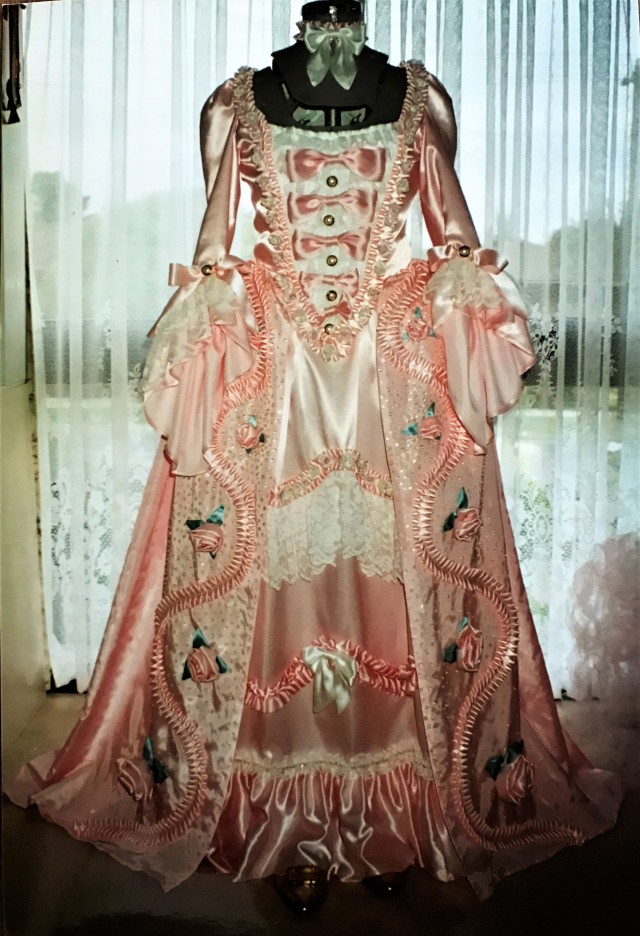

 The most challenging part of the construction for me was the boned stomacher of the gown. In the infancy of my sewing experience, I was not aware that I could have just bought synthetic boning. I had read that the ladies in the eighteenth century used real whale bones in their corsets to stiffen them. They were inserted in the narrow tunnels of the garment that had been sewn for the bones. Since I was more than unlikely to find whale bones for this purpose and being very creative and inventive as I was, I found something that was actually quite easy to access – a metal coat hanger, or two, or three. I used pliers to cut the lengths I needed and straightened them. Then, after sewing the narrow tunnels I inserted each piece. That worked quite well and the metal was very stiff too. They don’t make metal coat hangers like they used to! The problem was that the ends were sharp and I wasn’t sure if the metal would rust at some stage. I encased the ends as best I could by folding over the edge of the fabric and covering it with a white ribbon edging. They haven’t rusted yet in over 25 years! Did I just say 25 years!?
The most challenging part of the construction for me was the boned stomacher of the gown. In the infancy of my sewing experience, I was not aware that I could have just bought synthetic boning. I had read that the ladies in the eighteenth century used real whale bones in their corsets to stiffen them. They were inserted in the narrow tunnels of the garment that had been sewn for the bones. Since I was more than unlikely to find whale bones for this purpose and being very creative and inventive as I was, I found something that was actually quite easy to access – a metal coat hanger, or two, or three. I used pliers to cut the lengths I needed and straightened them. Then, after sewing the narrow tunnels I inserted each piece. That worked quite well and the metal was very stiff too. They don’t make metal coat hangers like they used to! The problem was that the ends were sharp and I wasn’t sure if the metal would rust at some stage. I encased the ends as best I could by folding over the edge of the fabric and covering it with a white ribbon edging. They haven’t rusted yet in over 25 years! Did I just say 25 years!?

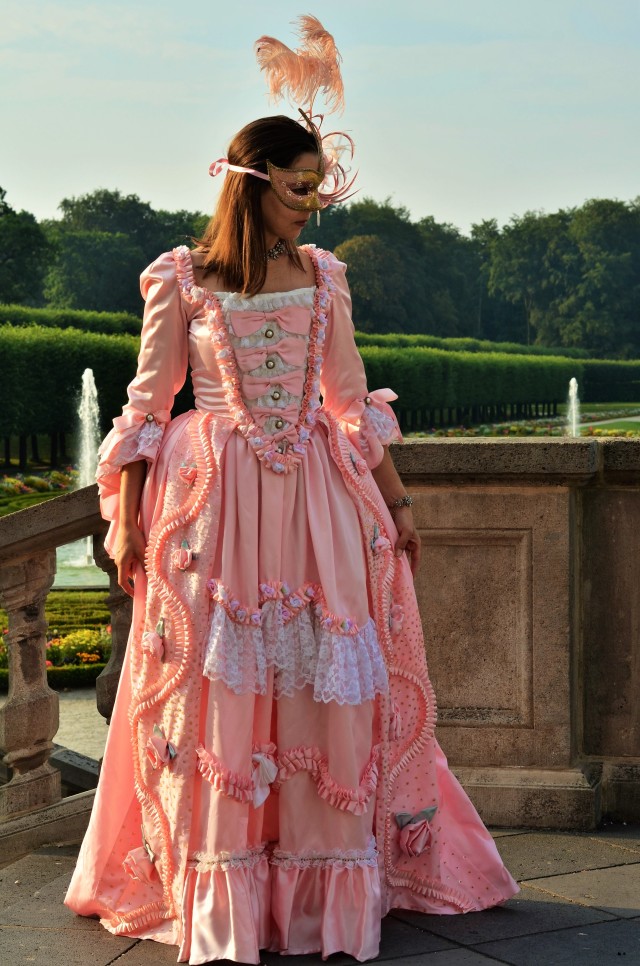 The bodice is completely lined in white linen – as they did so in those days. Even though some of the dress isn’t made using the materials and adornments that would have been used back in the eighteenth century, I did try to make it as close as possible to the original construction of the day, using modern construction methods of a sewing machine!
The bodice is completely lined in white linen – as they did so in those days. Even though some of the dress isn’t made using the materials and adornments that would have been used back in the eighteenth century, I did try to make it as close as possible to the original construction of the day, using modern construction methods of a sewing machine!
I was going to make a traditional petticoat, or paniers as some say at some stage, but never got around to it, so I just used a tulle layered skirt to puff up the dress as best as possible.
Here are some “real, old” photos of me wearing the gown in the Schlosspark in the early 1990s:


 And in July this year…
And in July this year…
During the many years I lived in Germany (at one stage only 5 mins walk away from the palace gardens where these photos were taken), I had tried to convince my other half to go the Venice Carnevale with me so that I could actually wear this creation. But to no avail. He would not be seen dead in stockings, knicker-bocker style pants and a wig and that was that! So this grand dame has only come out of the closet for a few photos and not much else in a very long time.
Looking back on this gown, I do feel the itch to make another one in another colour and cut. I started to make one in a heavy cream satin with gold embroidery that is about half way there but never finished it off for some reason. Maybe when winter hits again and the evenings are long, I will get back to completing it.
Hand sewing and beading are real highlights for me. I find it quite therapeutic to tack and hand stitch my clothes and actually really dislike having to sew them together on the sewing machine. I guess that’s why I loved making this ballgown. Amongst all the different parts that make up this gown, my favourite detail would have to be the sleeves. I absolutely love bell or gathered sleeves. Interesting to see bell sleeve garments making a huge come back at the moment… 


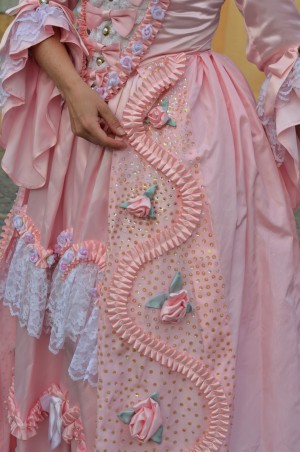
Beautiful tunnel of 300 year old beech trees at the Schlosspark
STYLING: mask – handmade Venetian, necklace and bracelet – Zara, shoes – stilista
LOCATION: Palace gardens Schlosspark, Brühl, Germany
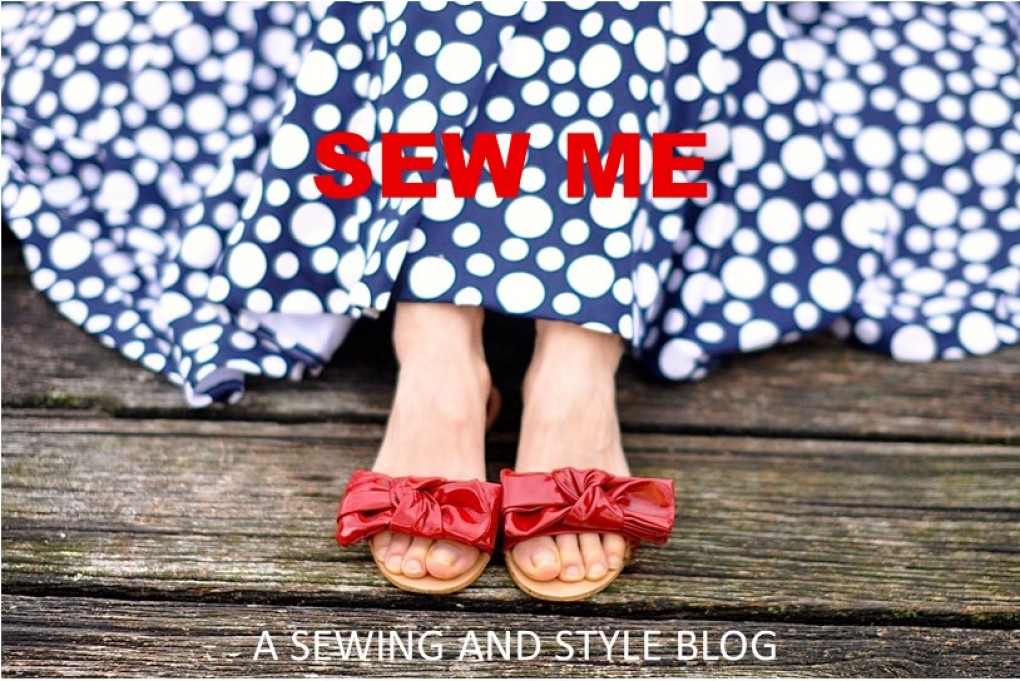



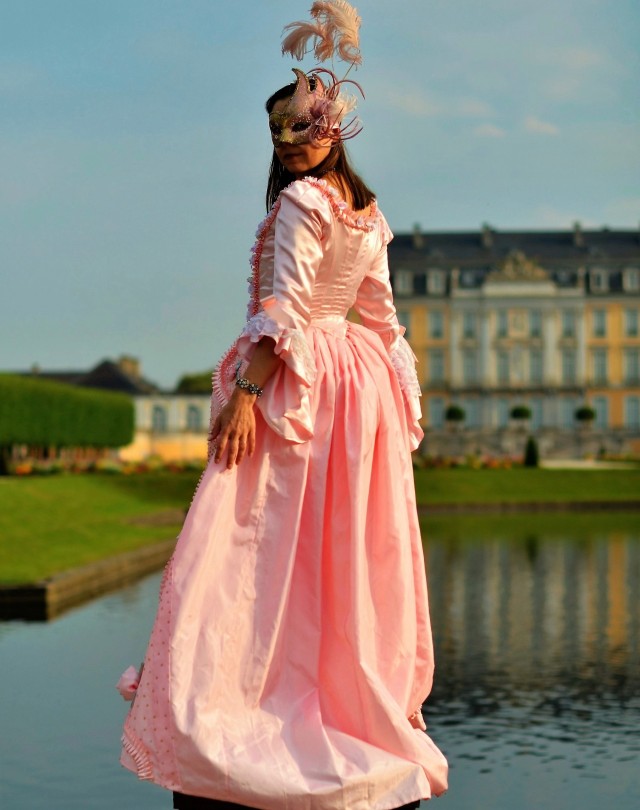

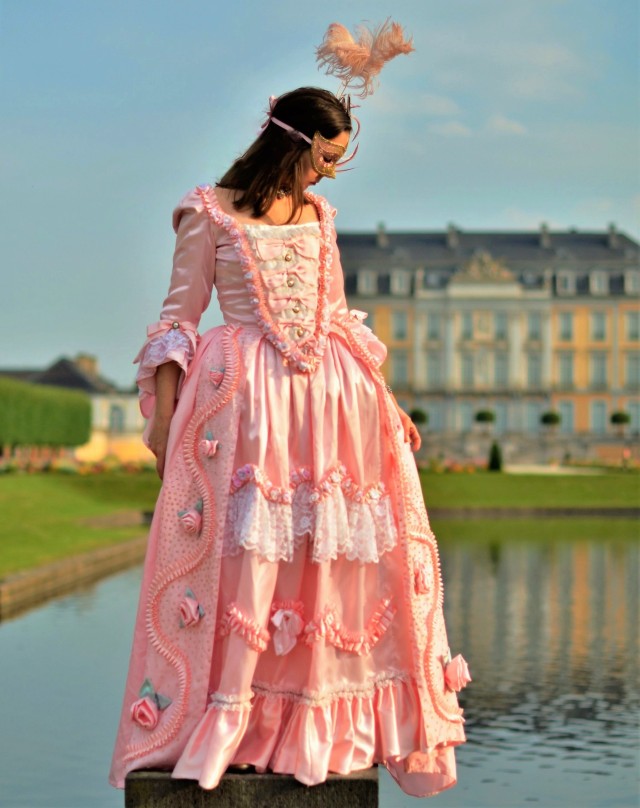





Aaahh, my incredibly talented sis has done it again 😊 I love this dress too, remember I modelled it in your apartment in Aachen when I came to visit you? But unlike you I wouldn’t fit into it anymore LOL
Thanks Sis, this gown almost fits into the category “vintage” after so many years…!
Vona, Stunning as always..That dress brings back great teenage memories 🙂
Yes it does, we were so carefree and had our heads in the clouds…
straight out of the fable … stunning! i didn’t know about Janet Arnold’s books … now I gotta have them all!
Thanks Sasha! The pattern books by Janet Arnold are very good. I also have Patterns of Fashion 2. Both very informative books😎